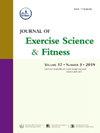Associations between dimensions of physical activity (intensity, frequency, duration, and volume) and frailty among middle-aged and older Chinese adults
IF 2.4
2区 医学
Q2 SPORT SCIENCES
引用次数: 0
Abstract
Objectives
Physical activity (PA) plays an essential role in preventing and delaying frailty. Although several studies have examined the association between PA and frailty in middle-aged and older adults, no research has considered all four PA dimensions including intensity, duration, frequency, and volume. This study examined the association between PA dimensions and the prevalence of frailty, and established PA cut-points for detecting the presence of frailty.
Methods
A total of 9389 individuals aged 40 or older from the China Health and Retirement Longitudinal Study were involved in this cross-sectional study. Frailty was assessed using the frailty index, which was calculated by the health deficit items. A self-reported questionnaire was used to collect information about PA intensity, duration, frequency, and volume. We employed logistic regression analysis to determine the associations between dimensions of PA and frailty, and receiver operating characteristic (ROC) curve analysis to examine the optimal PA cut-point for predicting frailty according to gender and age.
Results
The prevalence of frailty was 10.6 % in middle-aged and older adults. Spending at least 1–2 days, 10–29 min per day, and 10–149 min each week in vigorous-intensity PA, moderate-intensity PA or light-intensity PA were all related to a lower likelihood of frailty, with adjusted ORs (95 % CI) ranging from 0.21 (0.12, 0.37) to 0.56 (0.41, 0.75). A sensitivity analysis demonstrated that the association between the dimensions of PA and frailty remained unchanged after employing an alternative frailty criterion. ROC curves analysis indicated that the optimal PA cut-points to predict frailty were 733, 693, 693, and 471 MET-minutes per week for men, women, middle-aged adults, and older adults, respectively.
Conclusions
Regardless of PA intensity, even a short duration and low frequency of PA is linked to a lower likelihood of frailty. For middle-aged and older adults, the lower PA value may serve as an early sign indicating a greater prevalence of frailty. The findings provide insight into therapies aimed at preventing and treating frailty in middle-aged and older adults.
中国中老年人群体力活动维度(强度、频率、持续时间和量)与虚弱之间的关系
目的:体育活动在预防和延缓衰弱中发挥重要作用。虽然有几项研究调查了中老年人PA与虚弱之间的关系,但没有研究考虑到PA的所有四个维度,包括强度、持续时间、频率和体积。本研究考察了PA维度与虚弱患病率之间的关系,并建立了检测虚弱存在的PA切点。方法从中国健康与退休纵向研究中选取9389名40岁及以上的个体进行横断面研究。虚弱是用虚弱指数来评估的,虚弱指数是由健康赤字项目计算的。采用自我报告问卷收集PA强度、持续时间、频率和音量的信息。我们采用logistic回归分析来确定PA维度与虚弱之间的关系,并采用受试者工作特征(ROC)曲线分析来检验根据性别和年龄预测虚弱的最佳PA切点。结果中老年人群虚弱患病率为10.6%。每天至少1-2天,每天10-29分钟,每周10-149分钟的高强度、中等强度或低强度PA均与较低的虚弱可能性相关,调整后的or (95% CI)范围为0.21(0.12,0.37)至0.56(0.41,0.75)。敏感性分析表明,在采用另一种脆弱性标准后,PA维度与脆弱性之间的关联保持不变。ROC曲线分析显示,男性、女性、中年人和老年人的最佳PA切割点分别为每周733分钟、693分钟、693分钟和471分钟。结论:无论PA强度如何,即使是短时间和低频率的PA也与较低的虚弱可能性有关。对于中老年人,较低的PA值可能是一个早期迹象,表明更普遍的脆弱。这一发现为预防和治疗中老年人身体虚弱提供了新的思路。
本文章由计算机程序翻译,如有差异,请以英文原文为准。
求助全文
约1分钟内获得全文
求助全文
来源期刊
CiteScore
5.10
自引率
3.60%
发文量
54
审稿时长
31 days
期刊介绍:
The Journal of Exercise Science and Fitness is the official peer-reviewed journal of The Society of Chinese Scholars on Exercise Physiology and Fitness (SCSEPF), the Physical Fitness Association of Hong Kong, China (HKPFA), and the Hong Kong Association of Sports Medicine and Sports Science (HKASMSS). It is published twice a year, in June and December, by Elsevier.
The Journal accepts original investigations, comprehensive reviews, case studies and short communications on current topics in exercise science, physical fitness and physical education.

 求助内容:
求助内容: 应助结果提醒方式:
应助结果提醒方式:


